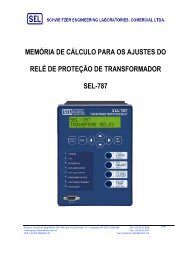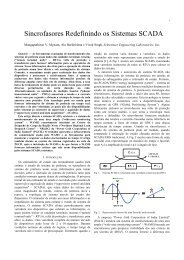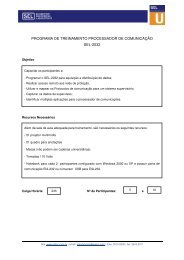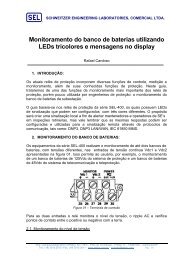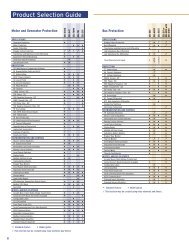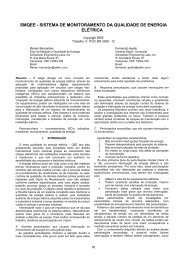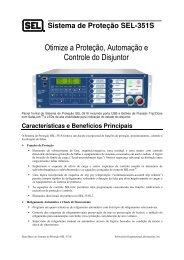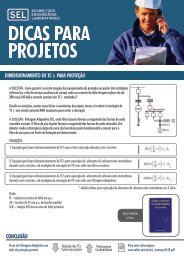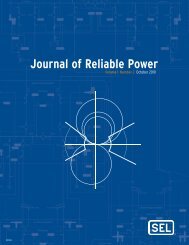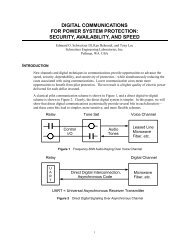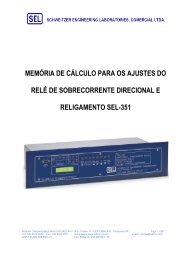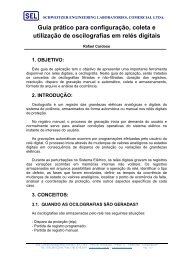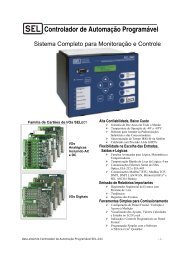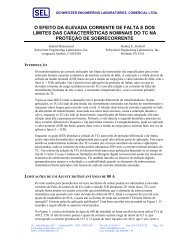Journal of Reliable Power - SEL
Journal of Reliable Power - SEL
Journal of Reliable Power - SEL
You also want an ePaper? Increase the reach of your titles
YUMPU automatically turns print PDFs into web optimized ePapers that Google loves.
6<br />
VI. ZONE 1 OVERREACH DUE TO CVT<br />
In July 2002, a 230 kV transmission line experienced a<br />
C-phase-to-ground (CG) fault. The local relay tripped by<br />
Zone 1 ground distance element for a fault that was physically<br />
located beyond the Zone 1 reach setting. A capacitive voltage<br />
transformer (CVT) supplies secondary voltage for the relay.<br />
The unfiltered event data from this misoperation are shown<br />
in Fig. 14. The event shows a severe transient in the C-phase<br />
voltage just before the Zone 1 CG distance element operation.<br />
This transient makes the C-phase voltage magnitude appear<br />
smaller to the relay than the actual voltage value. The apparent<br />
impedance calculated by the relay is smaller (or closer to the<br />
terminal) than actual. The CG distance element asserted in less<br />
than 1 cycle. When the fault clears, the C-phase voltage has<br />
another transient that makes it appear higher in magnitude<br />
than the other nonfault-affected phases.<br />
IA IB IC IRMag<br />
VA VB VC<br />
3V1 3I1<br />
VCMag<br />
Digitals<br />
1000<br />
0<br />
-1000<br />
100<br />
0<br />
-100<br />
1000<br />
0<br />
-1000<br />
IA IB IC IRMag VA<br />
VB VC 3V1 3I1 VCMag<br />
.75 cycles<br />
150<br />
100<br />
50<br />
0<br />
OUT 1&2 1 .<br />
32 Q<br />
ZCG 1<br />
Fig. 14.<br />
2 3 4 5 6 7 8 9 10 11<br />
Cycles<br />
CG Fault Produces CVT Transient<br />
Equation (1) and the data from the event allow us to<br />
calculate the source impedance ratio (SIR) for this application.<br />
CVTs with an active ferroresonance-suppression circuit (FSC)<br />
and applications with a high SIR limit secure Zone 1 reach<br />
settings [7]. The positive-sequence source impedance for this<br />
application is 11 ohms secondary and the line impedance is<br />
0.59 ohms secondary, giving an SIR <strong>of</strong> over 18.<br />
V1FAULT<br />
– V1PREFAULT<br />
SIR = (1)<br />
(I1 FAULT – I1PREFAULT)<br />
• Z1 LINE<br />
For an SIR <strong>of</strong> 18 and an active FSC, the maximum<br />
recommended Zone 1 reach is 0.07 pu <strong>of</strong> the line. With such a<br />
short line (small impedance), this results in a secondary<br />
setting below the minimum value allowed by the relay<br />
(0.05 ohms secondary). In this application, the Zone 1 element<br />
needs to be completely disabled or time-delayed by at least<br />
1.5 cycles. In some applications, another option is to split<br />
Zone 1 into two zones; one zone with reduced reach and set to<br />
trip instantaneously, and the other zone set to the desired or<br />
normal reach with time delay. This is a more complex<br />
solution, but it gives faster tripping for close-in faults and<br />
takes advantage <strong>of</strong> the multiple zones available in relays.<br />
Modern relays now include CVT transient detection logic.<br />
This logic detects SIRs greater than 5 during a fault and<br />
blocks the Zone 1 distance tripping for up to 1.5 cycles or<br />
until the distance calculation “smoothes,” indicating the<br />
transient has subsided. This logic is ideal for preventing<br />
distance element overreach for CVT transients. The raw event<br />
data in Fig. 14 were converted to IEEE COMTRADE files and<br />
replayed into a relay with CVT transient detection logic. With<br />
CVT transient detection logic turned <strong>of</strong>f, the relay<br />
overreached for every simulation. With CVT transient<br />
detection logic turned on, the logic correctly blocked the<br />
Zone 1 tripping for the entire 1.5-cycle duration and<br />
successfully prevented misoperation for all simulations.<br />
VII. CVT CAUSES RECLOSE FAILURE<br />
In June 2005, a 161 kV line experienced a BG fault. Both<br />
line ends use line-side CVTs. Fault data from the remote<br />
terminal are shown in Fig. 15, and fault data from the local<br />
terminal are shown in Fig. 16. Both terminals report balanced<br />
voltages and appropriate load currents flowing from the local<br />
to remote end before the fault occurs.<br />
For a BG fault that is forward to both terminals, we would<br />
expect the phase angle relationships shown in Fig. 15. However,<br />
voltage during the fault at the local end does not match<br />
that at the remote terminal.<br />
Fig. 15.<br />
Fig. 16.<br />
180<br />
135<br />
225<br />
VA<br />
VC<br />
90<br />
270<br />
IC<br />
VB<br />
IA<br />
IB<br />
45<br />
315<br />
Forward BG Fault as Viewed by Remote Line Relay<br />
180<br />
135<br />
225<br />
IC<br />
90<br />
VA<br />
IA<br />
270<br />
IB<br />
VC<br />
45<br />
VB<br />
315<br />
Forward BG Fault as Viewed by Local Line Relay<br />
Multiple CVT secondary grounds were suspected because<br />
the local prefault voltages were balanced and the fault voltages<br />
were corrupt. Technicians found two grounds, one at the<br />
CVT secondary wiring in the yard and another in the control<br />
building at the relay panel.<br />
Despite the CVT grounding problem, both terminals tripped<br />
correctly by a forward ground directional overcurrent element.<br />
0<br />
0<br />
Lessons Learned Analyzing Transmission Faults | 57



